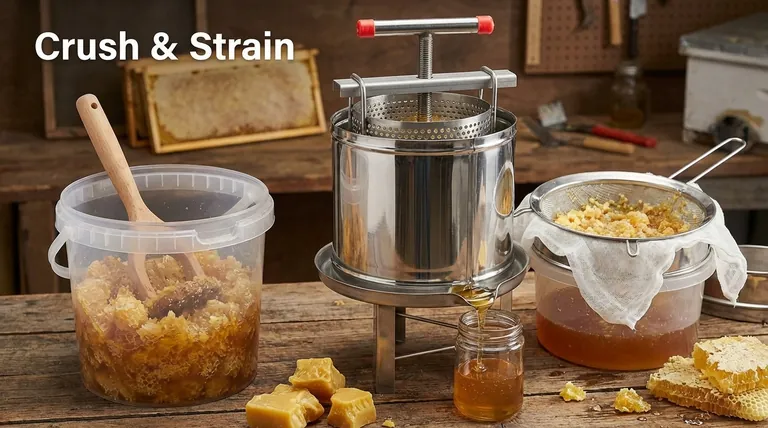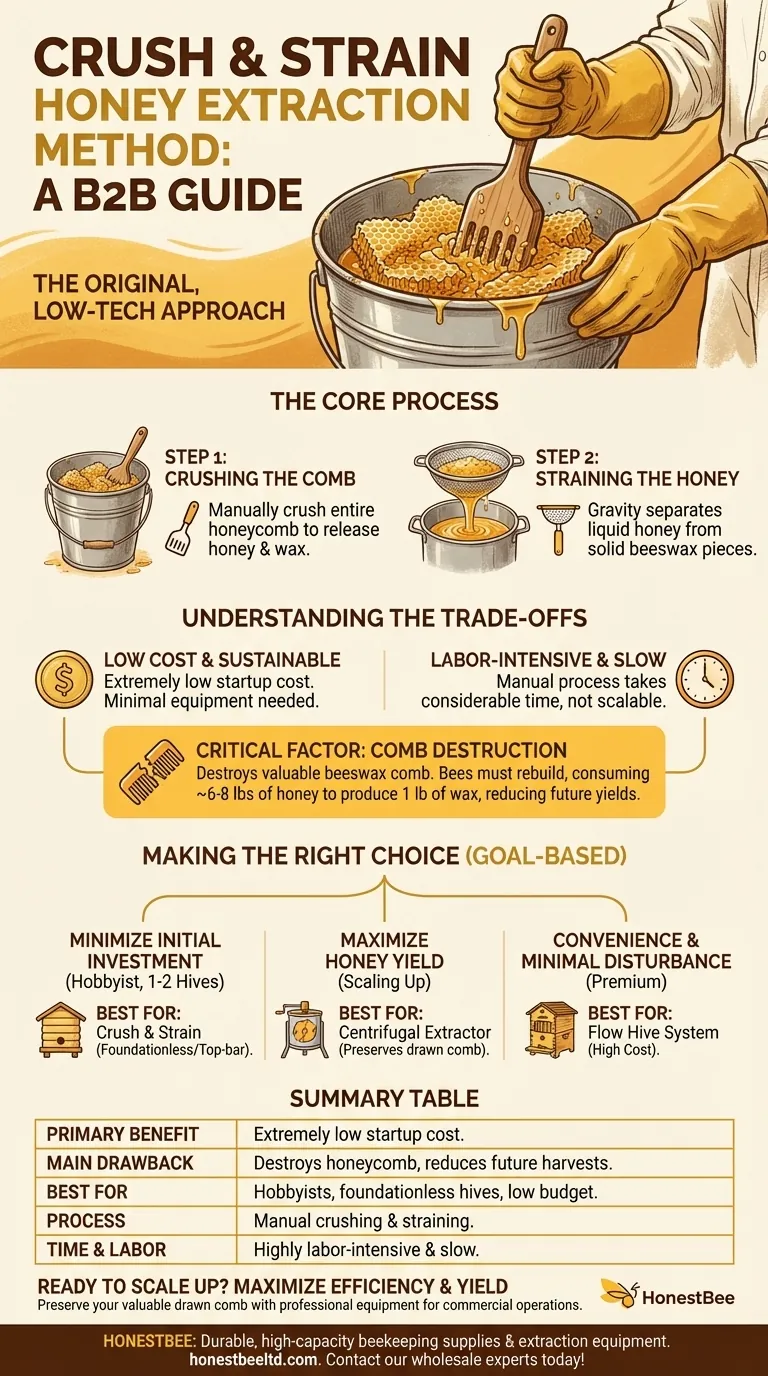The Crush & Strain method is the original, low-tech approach to honey extraction. It is characterized by its low cost, high sustainability, and suitability for hobbyists. The process involves manually crushing the entire honeycomb and then straining the resulting mixture to separate the pure honey from the beeswax.
The core decision to use the Crush & Strain method hinges on a single trade-off: it offers the lowest possible startup cost in exchange for sacrificing the honeycomb, which forces your bees to rebuild it from scratch each season.

The Core Process Explained
This method is straightforward and requires minimal specialized equipment, making it a common entry point for new beekeepers. The process is defined by its manual nature.
Step 1: Crushing the Comb
First, the entire honeycomb is removed from the frame. It is then placed in a food-grade bucket or container and mashed using a simple tool, such as a potato masher or a clean piece of wood, to break open all the wax cells and release the honey.
Step 2: Straining the Honey
Next, the mixture of honey and crushed wax is poured through a strainer or filter. This can be a dedicated honey filter, a fine-mesh sieve, or even several layers of cheesecloth. Gravity does the work, allowing the liquid honey to pass through while the solid wax pieces are left behind.
Ideal Use Cases
This method is particularly well-suited for foundationless combs, such as those from a top-bar hive, or any comb that is not built on a wire or plastic foundation. Trying to crush comb built on a foundation is messy and impractical.
Understanding the Trade-offs
While simple, the Crush & Strain method has significant implications for your apiary's productivity and your time commitment. Understanding these trade-offs is crucial.
The Cost vs. Time Equation
The primary benefit is the low cost. You avoid the need for a centrifugal extractor, which is often the most expensive piece of honey processing equipment.
However, this method is very slow and labor-intensive. The manual crushing and slow dripping process takes considerably more time than mechanical extraction, especially as the number of hives increases.
The Critical Factor: Comb Destruction
The most significant consequence of this method is that it destroys the beeswax comb. The frames cannot be reused in the hive for the bees to refill.
Bees must expend a tremendous amount of energy and consume significant amounts of nectar (estimated at 6-8 pounds of honey) just to produce one pound of wax. By removing the comb, you are forcing them to dedicate their resources to rebuilding rather than storing surplus honey.
This can directly impact the size of your next honey harvest, as the colony must first rebuild its internal structure before it can begin storing honey for you. In contrast, methods that use a centrifugal extractor or a Flow Hive preserve this valuable comb for immediate reuse.
Making the Right Choice for Your Goal
Selecting an extraction method depends entirely on your goals, budget, and the scale of your operation.
- If your primary focus is minimizing initial investment with only one or two hives: Crush & Strain is an excellent starting point that requires almost no specialized equipment.
- If your primary focus is maximizing your honey yield over multiple seasons: Investing in a centrifugal extractor is the logical next step to preserve your valuable drawn comb.
- If your primary focus is convenience and you want to harvest without disturbing the hive: The high-cost Flow Hive system is designed for this specific purpose, though it represents a very different philosophy of beekeeping.
Ultimately, choosing Crush & Strain is a deliberate decision that prioritizes simplicity and low startup cost over the long-term production efficiency gained by preserving comb.
Summary Table:
| Feature | Description |
|---|---|
| Primary Benefit | Extremely low startup cost; minimal equipment needed. |
| Main Drawback | Destroys the honeycomb, forcing bees to rebuild and reducing future harvests. |
| Best For | Hobbyists with 1-2 hives, foundationless/top-bar hives, and beekeepers prioritizing low initial investment. |
| Process | Manually crush honeycomb, then strain the mixture to separate honey from wax. |
| Time & Labor | Highly labor-intensive and slow compared to mechanical extraction methods. |
Ready to scale up your honey production?
For commercial apiaries and beekeeping equipment distributors, the labor-intensive nature of the Crush & Strain method quickly becomes a bottleneck. Maximize your efficiency and honey yields by preserving your valuable drawn comb with professional extraction equipment.
HONESTBEE supplies the durable, high-capacity beekeeping supplies and extraction equipment that commercial operations and distributors rely on. Let us help you build a more productive and profitable operation.
Contact our wholesale experts today to discuss your needs!
Visual Guide

Related Products
- Stainless Steel Manual Honey Press with Guard for Pressing Honey and Wax
- Stainless Steel Honey Press Wax Press with Tank
- 10L Stainless Steel Electric Honey Press Machine
- Electric Flatting and Embossing Machine with Tray for Beekeeping
- Honey Wax Separating Wax Press with Metal Screw Wax Separator Machine
People Also Ask
- What are the benefits of the screw design in a stainless steel honey pump? Preserve Honey Quality and Integrity
- What are the uses of honey in various industries? Unlock Its Functional Power in Food, Pharma & Cosmetics
- What are the key features of a honey press? Maximize Yield with Durable, Efficient Extraction
- How can a honey press be used beyond honey extraction? Unlock Its Full Potential for Your Farm
- What was the overall experience with the honey press? Maximize Yield for Small-Scale Beekeeping



















